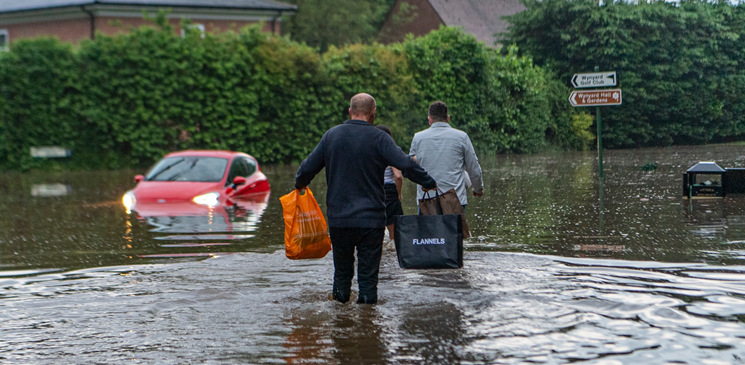What is flash flooding?
Flash flooding happens when very heavy rainfall causes water to accumulate rapidly, overwhelming the ground's ability to absorb it. This is more common in areas with impermeable surfaces such as tarmac, concrete, or dry, compacted soil or where the drainage system can’t cope with the excess water generated. In these conditions, water pools and starts flowing downhill, damaging properties, infrastructure, and the environment as the rate of surface water runoff rapidly increases.
Flash flooding can occur anywhere and at any time, but the risk is higher in the UK during the summer months. According to a study by the insurer Aviva, July and August accounted for 12% of all property flood claims received between 2013 and 2024, while June peaked at 9%. This indicates that while households and businesses should be prepared for flash floods year-round, extra caution should be exercised during the summer season.
Flash floods – some real-life examples
On 9 May last year, storms and heavy rain caused flash flooding in England and Wales. In Somerset and Devon, homes and roads were inundated, and severe flooding affected North Wales and parts of South East England. London experienced intense rainfall twice in July 2021, leading to several flood claims. On 12 July 2021, nearly a month's worth of rain fell in parts of London, causing significant damage and disruption. Five days later, 76mm of rain fell in just 90 minutes, resulting in floods along the Portobello Road. These incidents serve as stark reminders of the unpredictable and destructive nature of flash flooding.
The risks associated with flash flooding
As we’ve seen, flash floods are more likely to occur during intense summer storms in the UK. The risks associated with flash flooding can be summarised as follows:
- Property damage: Flash flooding can cause significant damage to buildings, including structural, electrical, and water damage.
- Loss of contents: A flash flood can irreparably damage or destroy the contents of your home or business.
- Displacement: In extreme cases, flash flooding can force people to evacuate their homes and businesses, leaving them without a place to live or work.
- Environmental impact: Beyond its immediate human cost, flash flooding can also harm the environment, polluting waterways, eroding soil, and disrupting ecosystems.
How to prepare for flash flooding
Preparing for flash floods involves a combination of planning, staying informed, and taking practical steps to protect your property, including having adequate Flood Insurance.
- Understand the risk
You can check if you’re at risk from flooding, including flash flooding, and access guidance on how to prepare for it by using the following resources:
Check the Met Office and sign up for weather warnings across the UK
Check for flooding in the next five days
Check your long-term flood risk
Sign up for flood warnings
Prepare for flooding. - Stay informed
Learn about your community’s emergency flood plan, warning signals, evacuation points and routes.
The Environment Agency (EA) urges communities at risk of flash floods to have a plan in place. This includes understanding the steps to stay safe during a flood event. A flood emergency plan toolkit is available to enable communities to create a flood emergency plan.
Some areas are in Rapid Response Catchments. This means that heavy rainfall can lead to flash flooding before flood warnings are issued.
If you suspect you live in an area at risk of flash flooding, sign up for EA flood warnings and make sure you understand the significance of a yellow or amber warning. Additionally, The British Red Cross offers an emergency App that can provide emergency alerts for your area. - Have a flood plan
A flood plan can help you prepare for flooding and reduce the impact it might have on your property. It should include a list of useful contact numbers, instructions on how to shut off your electricity or gas supply, and a plan for moving your valuable belongings to a safe place.
Also consider putting together an emergency flood kit with essential items that will help you cope in a flood, including insurance documents, medication, a torch, and spare batteries, a first aid kit, warm waterproof clothes, bottled water, and snacks. - Protect your property from flood damage
Consider installing flood protection products such as flood boards (flood barriers), plastic covers to seal airbricks, and sandbags. To reduce flood damage, you could lay tiles instead of carpets, move electrical sockets up the wall, and fit non-return valves.
Keep on top of basic maintenance work that keeps your home watertight. Repair the seals between the window and door frames and brickwork and ensure there are no gaps. Check gutters, downpipes, and drains regularly to make sure they’re working properly. - Ensure you have Flood Insurance
If you live in a flood-prone area, ensure you have Flood Insurance (if it’s not already included in your buildings and contents policy).
The importance of Flood Insurance
In the UK, the need for Flood Insurance has never been greater. Increasingly frequent and severe storms and heavy rainfall are leading to more flooding.
According to the EA, one in six properties in England is at risk of flooding. This risk is not confined to coastal areas or those near rivers; flash flooding can affect any area, especially those with poor drainage systems.
Flood Insurance plays a crucial role in protecting homeowners from the financial impact of a flood. Most buildings and contents insurance policies will include Flood Insurance as standard. It covers the cost of repairs or rebuilding work, allowing property owners to recover more quickly from the aftermath of a flood. Without adequate Flood Insurance, you could face significant out-of-pocket expenses to repair or replace damaged property.
The Role of government and insurance companies (Flood Re)
The harsh reality is that hundreds of thousands of properties could be more costly to insure because they’re at a greater risk of flooding. If your property is more likely to flood, then insurers may need to charge higher insurance premiums.
The UK Government and insurance companies recognise the impact this requirement may have on homeowners and have taken steps to ensure that Flood Insurance is available and affordable. The Government has partnered with insurers to create a scheme called Flood Re. This scheme helps homeowners living in flood-risk areas to find affordable insurance. Its aim is to make the flood cover part of household insurance policies more affordable.
Contact us
If you'd like to discuss Flood Insurance with one of our team, please call: 020 7280 3450 or email: enquiries@thecleargroup.com







